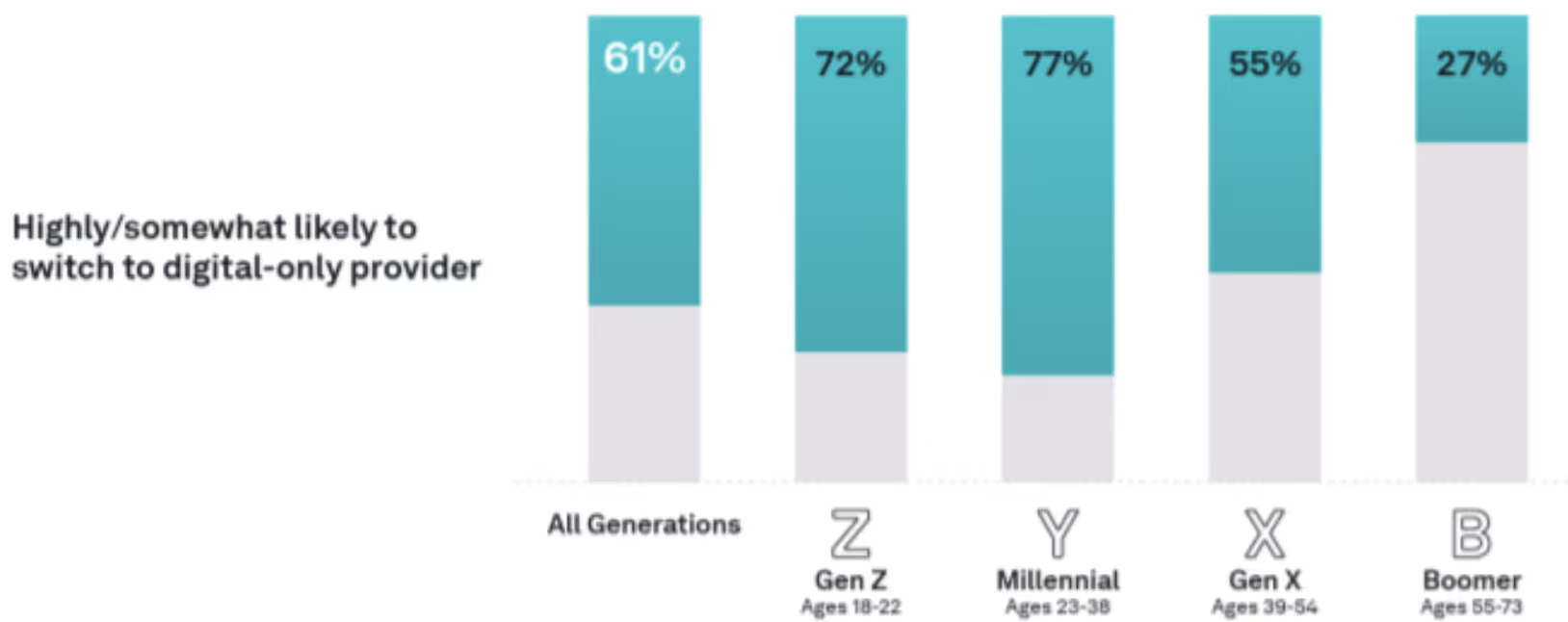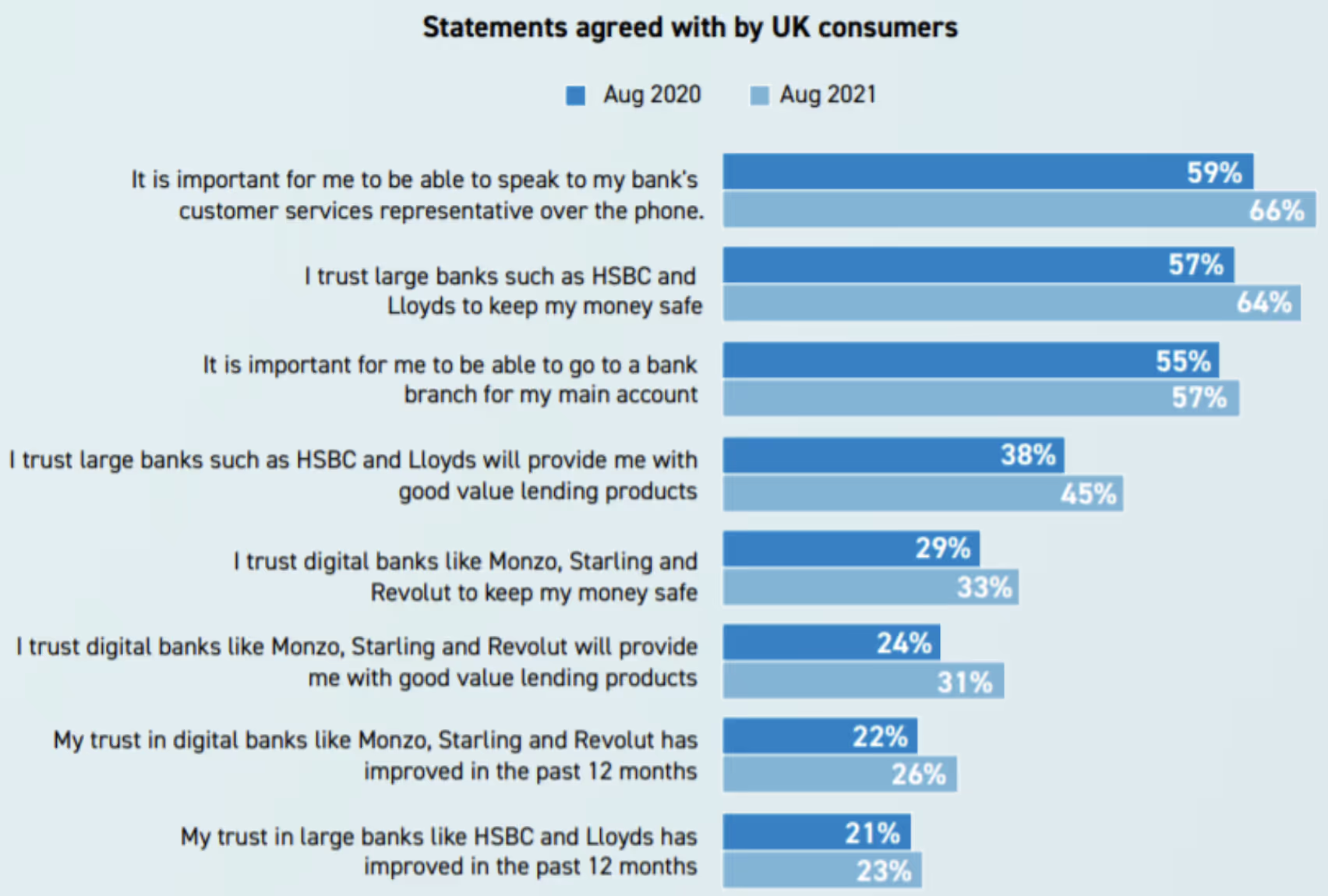The coronavirus pandemic has had a massive impact on how we interact with our banks. Customer spending habits have changed, use of cash has fallen, and great swathes of users have switched to digital channels to make payments and keep control of their finances.
As we move into 2022, what can we expect from banking customer experience? What do consumers want from these financial interactions? And how are established banking brands and industry disrupters meeting the needs of this fast-growing consumer base?
Here Are Our 10 Banking Customer Experience Trends To Watch In 2022:
1. The Shift To Digital Is Permanent
As some countries around the globe return to a state of something that at least resembles the times before Covid-19, you’d be forgiven for thinking that customers will revert back to the banking habits they had before the pandemic.
Research from Plaid suggests this is not the case. They found that in the US and the UK, 90% of fintech users plan to use digital banking as much or more after the pandemic. Why? Because it saves them time, money and reduces financial worries.
2. The Majority Of Consumers Plan To Switch To Digital-Only Banking
The customer experience of digital banking is arguably so good, that the majority of consumers are keen to make the change to pureplay digital-only banks.
This is according to a survey of 1000 US banking customers by Galileo.

They found that 61% of users across all generations say they are highly/somewhat likely to switch to a digital-only provider. This percentage increases if we dig down into the age groups of banking consumers, with 77% of Gen Y customers saying they are at least somewhat likely to make that switch.
3. Customer Experience Will Be The Key Differentiator Between Banks
Research from The Economist predicts that as we move into the new year, banks are looking to invest more time and money into differentiating themselves from their competitors by improving customer experience.
According to the Demanding More report, 81% of banks expect to prioritise customer experience over things like the products they offer. This is a direct result of consumer expectations changing during and after the pandemic.
The report quotes Michal Kissos Hertzog, chief executive of Israeli digital bank Pepper: ‘All banks have had to up their game, so competition has become stronger.’
4. Data Security Is A Concern Across All Age Groups
In an era where big data underpins better customer experience, security is clearly a concern for banking consumers.
Research from PYMNTS.com finds that data security is the leading reason customers won’t make the full switch to a digital-only bank. 33% of baby boomers and seniors cited data security as a concern, while significant numbers of younger users also worried about this aspect of digital banking too.
‘Banks and nonbanks that address data security concerns may position themselves to expand their market shares,’ the report suggests.
5. Increased Adoption Of Facial Recognition For Digi-Banking Security
Digital banks are already exploring how they can better keep our banking data safe in 2022.
Fresh research from authID.ai finds that 70% of fintech and banking executives are ‘either “highly likely” or “somewhat likely” to consider facial biometric identity authentication as an alternative to OTP/KBA questions during the next year.’
6. Mobile Apps And E-Wallets Will Be Key Touchpoints
McKinsey research carried out in the Asia-Pacific highlights that the region has reached a new level of fintech maturity – with 88% of consumers actively using digital banking. Mobile apps and e-wallets aren’t far behind – reaching 51% of all banking consumers.
Similarly, data published by Ericsson finds users in Sub-Saharan Africa embracing mobile money. Their Mobile financial services on the rise report finds that 75% of consumers agree ‘mobile money will reduce vulnerabilities for low-income people during economic, social and environmental shocks as well as disasters by helping the affected with money transactions.’
It is also seen as a boon for local businesses and social enterprises across the region.
7. Ultimately, Customers Want A Multichannel Experience
While digital channels are seeing massive adoption worldwide, the future of banking customer experience is multichannel.
A recent report from AltFi dives into this.

It found that 66% of UK consumers say it is important that they can speak to a customer services representative from their bank over the phone. Bricks and mortar branches remain popular too – alongside digital options. AltFi found that 57% of those they asked said it was important that they are able to go to a bank branch for their main account.
8. Gen Z Are A Key Driver For Good Digital Experiences
The Consumer Banking Report 2021 by Epam highlights the expectations among consumers aged 18-24.
‘When it comes to managing money, Gen Z is looking for more than just a current account,’ the report states. It finds that 43% of Gen Z respondents say access to a better digital experience is now more of a priority to them – with investment services, cryptocurrency integration, financial education and money management advice all being sought by those in this age bracket.
The report also points to this age group as the most ‘fearless’ when it comes to trying out new ways of looking after their money.
9. QR Codes Are Back
One of the more surprising digital side effects of the pandemic is the re-emergence of QR codes.
Here in the UK, we’ve seen them used for signing into locations for Track & Trace and they’ve also been incorporated into home-based Covid-19 tests to make them quicker for users to report their results.
In Australia, QR codes are also increasingly being used for payments. FIS Global have found in their 2021 PACE Pulse Report that 36% of consumers are using QR codes more often now as an alternative to cash when shopping in person. Additionally, 17% of consumers believe QR-as-payment will be here for the long term.
10. Banks To Have Unified Customer Intelligence Central To Their 2022 Strategy
In light of the drive for banks to differentiate themselves by the customer experience they offer, we’re expecting to see market leaders invest to better understand their customers.
A Unified Customer Intelligence platform like Chattermill provides people across the business with a holistic view of users as they interact across customer touchpoints – whether through customer support interactions or customer feedback.
The result for banks is that they are much better equipped to offer experiences for their customers based on what their customers actually say and think in their customer interactions and feedback – rather than making changes based on assumptions.
This can then help banks develop and improve their products and services to deliver what their customers actually want.
Unified Customer Intelligence is key to ensuring that in an increasingly omnichannel landscape, banks can remain competitive, agile, and give their customers precisely what they need. And that’s exactly why so many banks are making the shift to Chattermill.
Takeaways
With the ongoing Covid-19 pandemic, the banking sector has undoubtedly been faced with an era of challenge and opportunity.
How do branches adapt to social distancing? How can services be as accessible as possible? How can we ensure people’s finances are safe and secure at a time when digital transformation is so abrupt? Many of these questions are still being answered. But as we can see from the 10 trends above, the digitally-led omnichannel era of banking is here to stay.
Many digital banking users are happy enough with their experiences so far that they are keen to keep using these services. At the same time, there are a host of ways customer experience can be improved – particularly if banks can rise to the occasion of offering more in terms of education and investment assistance.
Today’s banking consumers want convenience and security, but they also want to feel supported. A good customer experience, one which is tailored to each customer and underpinned by unified, comprehensive customer data, will go a long way to achieving that.
See How Chattermill Can Help Power-Up Your Banking CX Strategy















